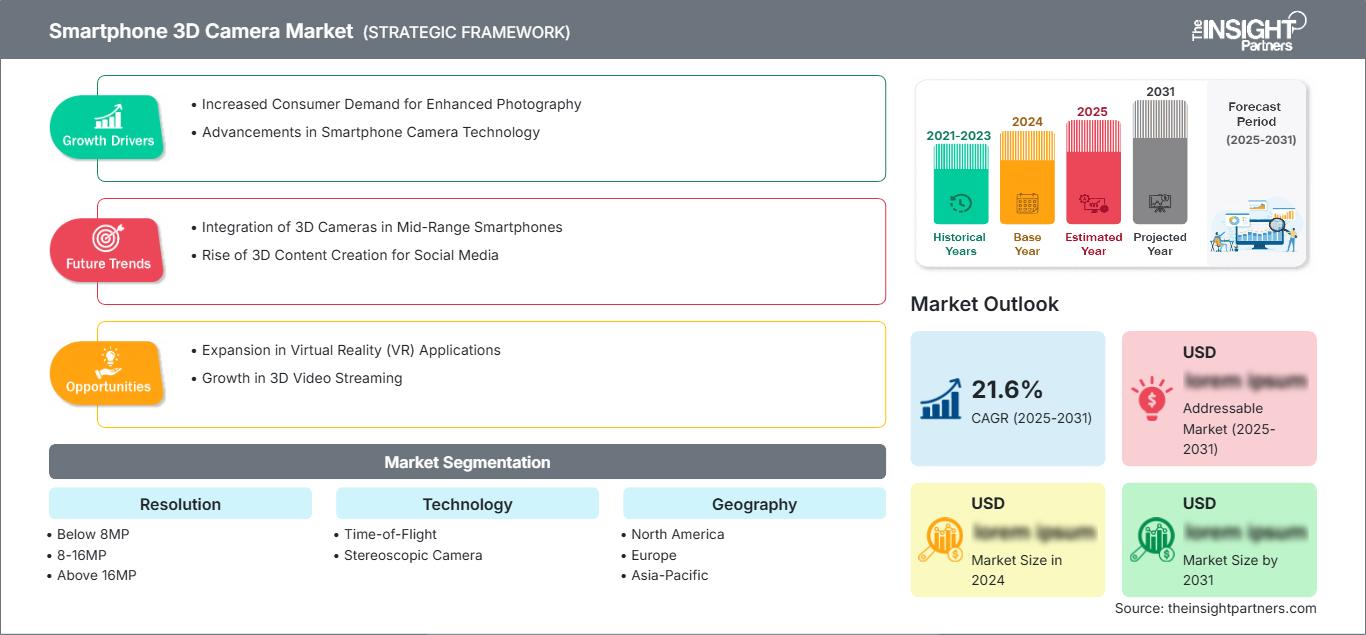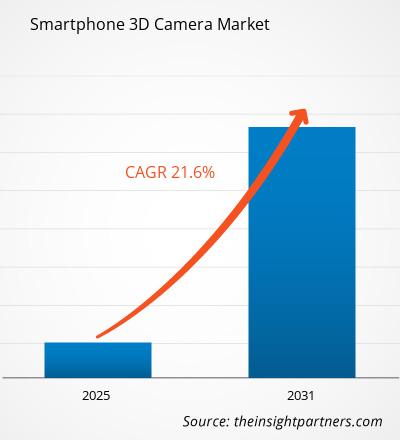Si prevede che il mercato delle fotocamere 3D per smartphone registrerà un CAGR del 21,6% dal 2025 al 2031, con una dimensione del mercato in espansione da XX milioni di dollari nel 2024 a XX milioni di dollari entro il 2031.
Il rapporto è segmentato in base alla risoluzione (inferiore a 8 MP, 8-16 MP, superiore a 16 MP) e alla tecnologia (Time-of-Flight (TOF), fotocamera stereoscopica). L'analisi globale è ulteriormente suddivisa a livello regionale e per i principali paesi. Il rapporto offre il valore in USD per l'analisi e i segmenti sopra indicati.
Scopo del rapporto
Il rapporto sul mercato delle fotocamere 3D per smartphone di The Insight Partners mira a descrivere il panorama attuale e la crescita futura, i principali fattori trainanti, le sfide e le opportunità. Ciò fornirà approfondimenti a vari stakeholder aziendali, come:
- Fornitori/produttori di tecnologia: per comprendere le dinamiche di mercato in evoluzione e conoscere le potenziali opportunità di crescita, consentendo loro di prendere decisioni strategiche informate.
- Investitori: per condurre un'analisi completa delle tendenze in merito al tasso di crescita del mercato, alle proiezioni finanziarie di mercato e alle opportunità esistenti lungo la catena del valore.
- Organismi di regolamentazione: per regolamentare le politiche e le attività di polizia nel mercato con l'obiettivo di ridurre al minimo gli abusi, preservare la fiducia degli investitori e sostenere l'integrità e la stabilità del mercato.
Risoluzione della segmentazione del mercato delle fotocamere 3D per smartphone
- Inferiore a 8 MP
- 8-16 MP
- Superiore a 16 MP
Tecnologia
- Time-of-Flight
- Fotocamera stereoscopica
Potrai personalizzare gratuitamente qualsiasi rapporto, comprese parti di questo rapporto, o analisi a livello di paese, pacchetto dati Excel, oltre a usufruire di grandi offerte e sconti per start-up e università
Mercato delle fotocamere 3D per smartphone: Approfondimenti strategici

-
Ottieni le principali tendenze chiave del mercato di questo rapporto.Questo campione GRATUITO includerà l'analisi dei dati, che vanno dalle tendenze di mercato alle stime e alle previsioni.
Fattori di crescita del mercato delle fotocamere 3D per smartphone
- Crescente domanda dei consumatori per una fotografia avanzata: la crescente preferenza dei consumatori per le funzionalità avanzate delle fotocamere, inclusa la fotografia 3D, è un fattore chiave del mercato delle fotocamere 3D per smartphone. Gli utenti sono alla ricerca di capacità di imaging più immersive e dinamiche sia per uso personale che professionale, il che ha portato a una maggiore adozione delle fotocamere 3D negli smartphone.
- Progressi nella tecnologia delle fotocamere degli smartphone: i progressi tecnologici nei sistemi di fotocamere degli smartphone, come obiettivi, sensori e intelligenza artificiale migliorati, stanno trainando il mercato delle fotocamere 3D per smartphone. Queste innovazioni consentono agli smartphone di catturare immagini e video 3D di alta qualità, offrendo un vantaggio competitivo ai produttori e attraendo i consumatori alla ricerca di funzionalità fotografiche all'avanguardia.
Tendenze future del mercato delle fotocamere 3D per smartphone
- Integrazione delle fotocamere 3D negli smartphone di fascia media: in precedenza limitate ai dispositivi di fascia alta, le fotocamere 3D vengono ora integrate negli smartphone di fascia media. Questa tendenza sta democratizzando l'accesso a funzionalità di imaging avanzate, ampliando il mercato delle fotocamere 3D e rendendole accessibili a una fascia più ampia di consumatori.
- Ascesa della creazione di contenuti 3D per i social media: con la crescente influenza delle piattaforme di social media, si sta assistendo a una crescente tendenza alla creazione di contenuti 3D. Gli utenti di smartphone utilizzano le fotocamere 3D per creare foto e video più coinvolgenti e interattivi per piattaforme come Instagram, TikTok e YouTube, incrementando la domanda di smartphone abilitati al 3D.
Opportunità di mercato per le fotocamere 3D per smartphone
- Espansione delle applicazioni di realtà virtuale (VR): con la crescente adozione della realtà virtuale (VR), le fotocamere 3D per smartphone rappresentano un'opportunità significativa. Le fotocamere 3D possono catturare contenuti immersivi, consentendo esperienze VR migliorate. I produttori possono capitalizzare su questa opportunità sviluppando smartphone dotati di fotocamere 3D avanzate per applicazioni incentrate sulla realtà virtuale, tra cui giochi, simulazioni e formazione.
- Crescita dello streaming video 3D: il crescente interesse per lo streaming video 3D, inclusi film 3D e video immersivi, offre un'importante opportunità per il mercato delle fotocamere 3D per smartphone. Con l'espansione dei servizi e delle piattaforme di streaming nella loro offerta di contenuti 3D, gli smartphone dotati di fotocamere 3D diventeranno essenziali per i consumatori che desiderano sperimentare contenuti multimediali 3D di alta qualità.
Approfondimenti regionali sul mercato delle fotocamere 3D per smartphone
Le tendenze e i fattori regionali che influenzano il mercato delle fotocamere 3D per smartphone durante il periodo di previsione sono stati ampiamente spiegati dagli analisti di The Insight Partners. Questa sezione analizza anche i segmenti e la geografia del mercato delle fotocamere 3D per smartphone in Nord America, Europa, Asia-Pacifico, Medio Oriente e Africa, America Meridionale e Centrale.
Ambito del rapporto di mercato delle fotocamere 3D per smartphone
| Attributo del rapporto | Dettagli |
|---|---|
| Dimensioni del mercato in 2024 | US$ XX million |
| Dimensioni del mercato per 2031 | US$ XX Million |
| CAGR globale (2025 - 2031) | 21.6% |
| Dati storici | 2021-2023 |
| Periodo di previsione | 2025-2031 |
| Segmenti coperti |
By Risoluzione
|
| Regioni e paesi coperti |
Nord America
|
| Leader di mercato e profili aziendali chiave |
|
Densità degli operatori del mercato delle fotocamere 3D per smartphone: comprendere il suo impatto sulle dinamiche aziendali
Il mercato delle fotocamere 3D per smartphone è in rapida crescita, trainato dalla crescente domanda degli utenti finali, dovuta a fattori quali l'evoluzione delle preferenze dei consumatori, i progressi tecnologici e una maggiore consapevolezza dei vantaggi del prodotto. Con l'aumento della domanda, le aziende stanno ampliando la propria offerta, innovando per soddisfare le esigenze dei consumatori e sfruttando le tendenze emergenti, alimentando ulteriormente la crescita del mercato.

- Ottieni il Mercato delle fotocamere 3D per smartphone Panoramica dei principali attori chiave
Punti di forza
- Copertura completa: il rapporto analizza in modo esaustivo prodotti, servizi, tipologie e utenti finali del mercato delle fotocamere 3D per smartphone, offrendo una panoramica olistica.
- Analisi degli esperti: il rapporto è redatto sulla base della conoscenza approfondita di esperti e analisti del settore.
- Informazioni aggiornate: il rapporto garantisce la pertinenza aziendale grazie alla copertura di informazioni e tendenze dei dati recenti.
- Opzioni di personalizzazione: questo rapporto può essere personalizzato per soddisfare le esigenze specifiche del cliente e adattarsi in modo appropriato alle strategie aziendali.
Il rapporto di ricerca sul mercato delle fotocamere 3D per smartphone può quindi contribuire a guidare il percorso di decodificazione e comprensione dello scenario del settore e delle prospettive di crescita. Sebbene possano esserci alcune preoccupazioni valide, i vantaggi complessivi di questo rapporto tendono a superare gli svantaggi.
- Analisi storica (2 anni), anno base, previsione (7 anni) con CAGR
- Analisi PEST e SWOT
- Valore/volume delle dimensioni del mercato - Globale, Regionale, Nazionale
- Industria e panorama competitivo
- Set di dati Excel
Report recenti
Rapporti correlati
Testimonianze
Motivo dell'acquisto
- Processo decisionale informato
- Comprensione delle dinamiche di mercato
- Analisi competitiva
- Analisi dei clienti
- Previsioni di mercato
- Mitigazione del rischio
- Pianificazione strategica
- Giustificazione degli investimenti
- Identificazione dei mercati emergenti
- Miglioramento delle strategie di marketing
- Aumento dell'efficienza operativa
- Allineamento alle tendenze normative






















 Ottieni un campione gratuito per - Mercato delle fotocamere 3D per smartphone
Ottieni un campione gratuito per - Mercato delle fotocamere 3D per smartphone